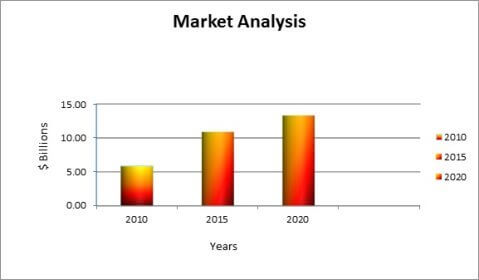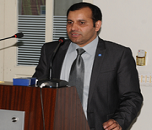Theme: Probing the knowhow of Battery and Fuel Cell Technology
Battery Tech 2017
Pimary Batteries
Primary Batteries are one of the major classifications of the battery types which are sometimes known as single-use or throw-away batteries since these are not rechargeable or reused. These batteries on assembly can generate the current and these are most commonly used in the portable devices which have a low current drain.
The global primary batteries market on the current forecasts that the primary batteries grow at a CAGR of 4.6% during the period of 2016-2020 which estimates the present scenario and the development aspects of the primary batteries.
Recommended Conferences:
2nd International Conference on Battery Technology, July 27-28, Rome, Italy; 2nd International Conference on Power Engineering, July 20-21, 2017 Munich, Germany; 2nd International Conference on Fluid Dynamics, October 19-20, 2017, Rome, Italy; 2nd International Conference on Design Engineering, August 21-22, 2017, Birmingham, UK; 2nd International Conference on Fuel Cell Technology, July 27-28, Rome, Italy; 2nd International Conference on Energy Engineering, Munich, Germany, July 20-21, 2017; 2nd International Conference on Production Engineering, August 21-22, 2017, Birmingham, UK; 2nd International Conference on Aerodynamics, October 19-20, 2017, Rome, Italy; Battery Power 2017, May 17-18, 2017, Dallas; International Battery Seminar & Exhibit, March 20-23, 2017, Florida; Advanced Automotive Battery Conferences, Jan 30- Feb 02, 2017, Germany; Energy Storage Conference 2017, February 8-9, Paris.
Battery Council International BCI, India Lead Zinc Development Association, Canadian Battery Association, Energy Storage Association, British and Irish Portable Battery Association.
Secondary Batteries
These are the rechargeable batteries and a type of electrical battery which can be charged many times, discharged into a load. With the recent market analysis on the secondary batteries the value of which has estimated more than $111 billion by 2019 which is influenced by the factors like cost and power capabilities. Several different mixtures of electrolytes and electrode materials are used. These rechargeable batteries manufactured in many different shapes, battery sizes ranging from button cells to megawatt systems.
Recommended Conferences:
2nd International Conference on Fuel Cell Technology, July 27-28, Rome, Italy; 2nd International Conference on Aerodynamics, October 19-20, 2017, Rome, Italy; 2nd International Conference on Production Engineering, August 21-22, 2017, Birmingham, UK; 2nd International Conference on Energy Engineering, Munich, Germany, July 20-21, 2017; 2nd International Conference on Battery Technology, July 27-28, Rome, Italy; 2nd International Conference on Fluid Dynamics, October 19-20, 2017, Rome, Italy; 2nd International Conference on Design Engineering, August 21-22, 2017, Birmingham, UK; 2nd International Conference on Power Engineering, July 20-21, 2017 Munich, Germany; 6th International Confernece on Fuel Cell and Hydrogen Technology, 11-13 April, 2017, Malaysia; 19th International Conference on Lithium Batteries, March 9-10, 2017, USA; 7th World Hydrogen Technology Convention, July 9-12, Prague.
Danish Battery Society, PRBA, The Rechargeable Battery association, Battery Vehicle Society BVS, Canadian Battery Association.
Theory of Batteries
Battery is a device consisting of one or more electrochemical cells with external connections connected to energize the electrical devices. A battery has a cathode, and an anode. The name "battery" commonly denoted to a device composed of multiple cells, yet the procedure has advanced to additionally include devices consisting of a single cell. Batteries are categorized into primary and secondary types. Primary batteries such as alkaline battery, leclanché cell, lithium battery are irreversibly transforming chemical energy to electrical energy. When the power inside the reactants got exhausted, these batteries such as primary does not restore energy easily. Secondary batteries such as flow battery, fuel cell, lead acid battery etc. can be recharged; that is, they can reverse their chemical reactions by supplying electrical energy to the battery, by restoring their original composition.
Recommended Conferences:
2nd International Conference on Battery Technology, July 27-28, Rome, Italy; 2nd International Conference on Fuel Cell Technology, July 27-28, Rome, Italy; 2nd International Conference on Aerodynamics, October 19-20, 2017, Rome, Italy; 2nd International Conference on Fluid Dynamics, October 19-20, 2017, Rome, Italy; 2nd International Conference on Design Engineering, August 21-22, 2017, Birmingham, UK; 2nd International Conference on Production Engineering, August 21-22, 2017, Birmingham, UK; 2nd International Conference on Energy Engineering, Munich, Germany, July 20-21, 2017; 2nd International Conference on Power Engineering, July 20-21, 2017 Munich, Germany; 19th International Conference on Lithium Batteries, March 9-10, 2017, USA; International Battery Seminar & Exhibit, March 20-23, 2017, Florida; Advanced Automotive Battery Conferences, Jan 30- Feb 02, 2017, Germany; Energy Storage Conference 2017, February 8-9, Paris.
Danish Battery Society, PRBA The Rechargeable Battery association, Battery Association of Japan BAJ, Battery Vehicle Society BVS, Canadian Battery Association.
Design and Technology of Batteries
The internal function of a battery are typically contained within a metal or plastic case. Under this metal there is a cathode, which connects to the positive terminal, and an anode which connects to the negative terminal. These constituents, more generally known as electrodes, occupy most of the space in a battery and are placed where the chemical reactions occur. A partition creates a barrier between the cathode and anode, preventing the electrodes from moving while allowing electrical charge to flow freely between them. The medium that allows the electric charge to flow between the cathode and anode is known as the electrolyte. Finally, the collector conducts the charge to the outside of the battery and through the load.
Battery Council International BCI, India Lead Zinc Development Association, Canadian Battery Association, Energy Storage Association, British and Irish Portable Battery Association.
Recommended Conferences:
2nd International Conference on Battery Technology, July 27-28, Rome, Italy; 2nd International Conference on Power Engineering, July 20-21, 2017 Munich, Germany; 2nd International Conference on Fluid Dynamics, October 19-20, 2017, Rome, Italy; 2nd International Conference on Design Engineering, August 21-22, 2017, Birmingham, UK; 2nd International Conference on Fuel Cell Technology, July 27-28, Rome, Italy; 2nd International Conference on Energy Engineering, Munich, Germany, July 20-21, 2017; 2nd International Conference on Production Engineering, August 21-22, 2017, Birmingham, UK; 2nd International Conference on Aerodynamics, October 19-20, 2017, Rome, Italy; 6th International Confernece on Fuel Cell and Hydrogen Technology, 11-13 April, 2017, Malaysia; Advanced Automotive Battery Conferences, Jan 30- Feb 02, 2017, Germany; 7th World Hydrogen Technology Convention, July 9-12, Prague.
Danish Battery Society, PRBA The Rechargeable Battery association, Battery Association of Japan BAJ, Battery Vehicle Society BVS, Canadian Battery Association.
Latest Developments in Batteries
New Developments in Battery Technology such as Electric cars discusses the use of batteries as motive power sources in electric vehicles, as well as temporary energy storage in hybrid and solar powered vehicles. Lithium-Metal-Polymer battery contains no liquid or paste electrolyte. The electrolyte is in the form of a polymer film, resulting in a lightweight battery that is rugged, required little maintenance, and can tolerate extremes of temperatures in service lives as long as 10 years. A new development offered by Proctor & Gamble, not yet on the market. It is low-power electrolysis technology that can remove pathogens from small or large quantities of water. The technology is offered for licensing through yet2.com as a TechPak and even more.
Battery Council International BCI, India Lead Zinc Development Association, Canadian Battery Association, Energy Storage Association, British and Irish Portable Battery Association.
Recommended Conferences:
2nd International Conference on Battery Technology, July 27-28, Rome, Italy; 2nd International Conference on Aerodynamics, October 19-20, 2017, Rome, Italy; 2nd International Conference on Fuel Cell Technology, July 27-28, Rome, Italy; 2nd International Conference on Design Engineering, August 21-22, 2017, Birmingham, UK; 2nd International Conference on Power Engineering, July 20-21, 2017 Munich, Germany; 2nd International Conference on Production Engineering, August 21-22, 2017, Birmingham, UK; 2nd International Conference on Fluid Dynamics, October 19-20, 2017, Rome, Italy; 2nd International Conference on Energy Engineering, Munich, Germany, July 20-21, 2017; Energy Storage Conference 2017, February 8-9, Paris; International Battery Seminar & Exhibit, March 20-23, 2017, Florida; Advanced Automotive Battery Conferences, Jan 30- Feb 02, 2017, Germany.
Nanotechnology in adavanced Batteries
Nano batteries are fabricated batteries employing technology at the Nano scale, a scale of microscopic particles that amount less than 100 nanometres or 10−7 meters. In contrast, out-dated Li-Ion technology uses active materials, such as cobalt-oxide, with atoms or particles that range in size between 5 and 20 micrometres (5000 and 20000 nanometres - over 100 times Nano scale). It is hoped that Nano-engineering will improve many of the inadequacies of present battery technology, such as recharging time and battery 'memory'. Several companies are exploring and emerging these technologies. In March 2005, Toshiba announced that they had a new Lithium-Ion battery consists a nanostructured lattice at the positive and negative terminals that permits the battery to recharge a astonishing eighty times quicker than previously. Prototype models were able to charge to eighty per cent capacity in one minute, and were one hundred per cent recharged after 10 minutes.
Recommended Conferences:
2nd International Conference on Fuel Cell Technology, July 27-28, Rome, Italy; 2nd International Conference on Energy Engineering, Munich, Germany, July 20-21, 2017; 2nd International Conference on Fluid Dynamics, October 19-20, 2017, Rome, Italy; 2nd International Conference on Battery Technology, July 27-28, Rome, Italy; 2nd International Conference on Aerodynamics, October 19-20, 2017, Rome, Italy; 2nd International Conference on Design Engineering, August 21-22, 2017, Birmingham, UK; 2nd International Conference on Production Engineering, August 21-22, 2017, Birmingham, UK; 2nd International Conference on Power Engineering, July 20-21, 2017 Munich, Germany; International Battery Seminar & Exhibit, March 20-23, 2017, Florida; Advanced Automotive Battery Conferences, Jan 30- Feb 02, 2017, Germany; 6th International Confernece on Fuel Cell and Hydrogen Technology, 11-13 April, 2017, Malaysia.
Battery Council International BCI, India Lead Zinc Development Association, Canadian Battery Association, Energy Storage Association, British and Irish Portable Battery Association.
Batteries in Renewable sources
It is expensive but makes economic sense, solar panels with the battery backup are necessary in the parts of Africa in order to support household activities. The photovoltaic solar cells are most commonly used and are fashionable in the Western world where the electricity is more expensive. Producing clean energy form the renewable sources should never be shortened, especially if it can be stored.
Recommended Conferences:
2nd International Conference on Battery Technology, July 27-28, Rome, Italy; 2nd International Conference on Aerodynamics, October 19-20, 2017, Rome, Italy; 2nd International Conference on Fuel Cell Technology, July 27-28, Rome, Italy; 2nd International Conference on Design Engineering, August 21-22, 2017, Birmingham, UK; 2nd International Conference on Power Engineering, July 20-21, 2017 Munich, Germany; 2nd International Conference on Production Engineering, August 21-22, 2017, Birmingham, UK; 2nd International Conference on Fluid Dynamics, October 19-20, 2017, Rome, Italy; 2nd International Conference on Energy Engineering, Munich, Germany, July 20-21, 2017; 6th International Confernece on Fuel Cell and Hydrogen Technology, 11-13 April, 2017, Malaysia;Energy Storage Conference 2017, February 8-9, Paris;19th International Conference on Lithium Batteries, March 9-10, 2017, USA; 7th World Hydrogen Technology Convention, July 9-12, Prague.
Applications of Batteries
Presenting large batteries for stationary applications, e.g. energy storage, and also batteries for hybrid vehicles or different tools. Secondary Battery such as Lithium batteries are used in various types of mobile devices, including communication equipment, computers, entertainment devices, power tools, toys, games, lighting and medical devices. Mostly in transportation the lithium secondary batteries stimulated to reduce carbon emissions in the Kyoto Protocol and demand for eco-friendly vehicles through CARB(California Air Resource Board). The Toyota Prius was the first commercial HEV. This vehicle uses NIMH batteries for power sources and presents a solution to the problem of high power density.
Danish Battery Society, PRBA The Rechargeable Battery association, Battery Association of Japan BAJ, Battery Vehicle Society BVS, Canadian Battery Association.
Recommended Conferences:
2nd International Conference on Fuel Cell Technology, July 27-28, Rome, Italy; 2nd International Conference on Aerodynamics, October 19-20, 2017, Rome, Italy; 2nd International Conference on Production Engineering, August 21-22, 2017, Birmingham, UK; 2nd International Conference on Energy Engineering, Munich, Germany, July 20-21, 2017; 2nd International Conference on Battery Technology, July 27-28, Rome, Italy; 2nd International Conference on Fluid Dynamics, October 19-20, 2017, Rome, Italy; 2nd International Conference on Design Engineering, August 21-22, 2017, Birmingham, UK; 2nd International Conference on Power Engineering, October 19-20, 2017, Rome, Italy, 6th International Confernece on Fuel Cell and Hydrogen Technology, 11-13 April, 2017, Malaysia.
Classifications of Fuel Cells
Based on the type of electrolyte used the fuel cells are classified as Proton Exchange membrane, molten carbonate, solid oxide, alkaline, phosphoric acid fuel cells and based on and the type of fuel and oxidant used they are categorized as Hydrogen-oxygen, ammonia-air, hydrazine-oxygen, hydrocarbon. The most important design features in fuel cell are the type of fuel cell is usually defined the electrolyte, Hydrogen is the most common fuel used substance etc.
Recommended Conferences:
2nd International Conference on Battery Technology, July 27-28, Rome, Italy; 2nd International Conference on Fuel Cell Technology, July 27-28, Rome, Italy; 2nd International Conference on Aerodynamics, October 19-20, 2017, Rome, Italy; 2nd International Conference on Fluid Dynamics, October 19-20, 2017, Rome, Italy; 2nd International Conference on Design Engineering, August 21-22, 2017, Birmingham, UK; 2nd International Conference on Production Engineering, August 21-22, 2017, Birmingham, UK; 2nd International Conference on Energy Engineering, Munich, Germany, July 20-21, 2017; 2nd International Conference on Power Engineering, July 20-21, 2017 Munich, Germany; International Battery Seminar & Exhibit, March 20-23, 2017, Florida; 19th International Conference on Lithium Batteries, March 9-10, 2017, USA; 7th World Hydrogen Technology Convention, July 9-12, Prague.
Applications of Fuel Cells
The fuel cells usage has been broadly in three areas: stationary power generation and power generation, portable power generation and power for transportation and they are also include a category for distribution, storage, fuel and infrastructure and dispensing of fuel cells in order for the implementation of fuel cell technology.
Recommended Conferences:
2nd International Conference on Battery Technology, July 27-28, Rome, Italy; 2nd International Conference on Power Engineering, July 20-21, 2017 Munich, Germany; 2nd International Conference on Fluid Dynamics, October 19-20, 2017, Rome, Italy; 2nd International Conference on Design Engineering, August 21-22, 2017, Birmingham, UK; 2nd International Conference on Production Engineering, August 21-22, 2017, Birmingham, UK; 2nd International Conference on Energy Engineering, Munich, Germany, July 20-21, 2017; 2nd International Conference on Aerodynamics, October 19-20, 2017, Rome, Italy; 2nd International Conference on Fuel Cell Technology, July 27-28, Rome, Italy; 19th International Conference on Lithium Batteries, March 9-10, 2017, USA; Energy Storage Conference 2017, February 8-9, Paris.
Battery Council International BCI, India Lead Zinc Development Association, Canadian Battery Association, Energy Storage Association, British and Irish Portable Battery Association.
Hydrogen Energy
Hydrogen which is the most abundant element in our earth’s crust can be generated from several resources like renewable and nuclear energy. It is considered to be same as that of electricity as a clean energy carrier. It is an important carrier of energy in future and has a number of advantages as it has high efficiency, low polluting fuel, power generation and heating. In order to separate the hydrogen from the other compounds the steam reforming is the technique which is least expensive for generating. The other method is electrolysis. The hydrogen generator plans need to be increased since it has a drastic usage.
As it is easily made from the renewable resources it joins electricity as the important energy carrier in the future.
Recommended Conferences:
2nd International Conference on Fuel Cell Technology, July 27-28, Rome, Italy; 2nd International Conference on Aerodynamics, October 19-20, 2017, Rome, Italy; 2nd International Conference on Production Engineering, August 21-22, 2017, Birmingham, UK; 2nd International Conference on Energy Engineering, Munich, Germany, July 20-21, 2017; 2nd International Conference on Battery Technology, July 27-28, Rome, Italy; 2nd International Conference on Fluid Dynamics, October 19-20, 2017, Rome, Italy; 2nd International Conference on Design Engineering, August 21-22, 2017, Birmingham, UK; 2nd International Conference on Energy Engineering, October 19-20, 2017, Rome, Italy;7th World Hydrogen Technology Convention, July 9-12, Prague; International Battery Seminar & Exhibit, March 20-23, 2017, Florida; Advanced Automotive Battery Conferences, Jan 30- Feb 02, 2017, Germany; Energy Storage Conference 2017, February 8-9, Paris.
Danish Battery Society, PRBA The Rechargeable Battery association, Battery Association of Japan BAJ, Battery Vehicle Society BVS, Canadian Battery Association.
Super Capacitors VS battery
The mechanisms of the super capacitor are can be quickly charged and has very high density of power. It had a different storage mechanism and stores electrostatically on its surface and has no chemical reactions involved in it. the cost of a super capacitor exceeds that of the battery materials because of the super capacitor materials such as graphene which is a high performing material.
Danish Battery Society, PRBA The Rechargeable Battery association, Battery Association of Japan BAJ, Battery Vehicle Society BVS, Canadian Battery Association.
Recommended Conferences:
2nd International Conference on Battery Technology, July 27-28, Rome, Italy; 2nd International Conference on Aerodynamics, October 19-20, 2017, Rome, Italy; 2nd International Conference on Fuel Cell Technology, July 27-28, Rome, Italy; 2nd International Conference on Design Engineering, August 21-22, 2017, Birmingham, UK; 2nd International Conference on Power Engineering, July 20-21, 2017 Munich, Germany; 2nd International Conference on Production Engineering, August 21-22, 2017, Birmingham, UK; 2nd International Conference on Fluid Dynamics, October 19-20, 2017, Rome, Italy; 2nd International Conference on Energy Engineering, Munich, Germany, July 20-21, 2017, 6th International Confernece on Fuel Cell and Hydrogen Technology, 11-13 April, 2017, Malaysia; International Battery Seminar & Exhibit, March 20-23, 2017, Florida; 19th International Conference on Lithium Batteries, March 9-10, 2017, USA.
Varous Energy Materials
Energy is the single most valuable resource for human activity and the basis for all human progress. Materials play a key role in enabling technologies that can offer promising solutions to achieve renewable and sustainable energy pathways for the future. Materials plays an important role in the supporting the technologies that can bid the solutions to get the sustainable and the renewable energies in the future as the energy play a major role for the humans. Materials for saving energy: Thermoelecrics, Energy saving buildings. Materials for renewable energy storage conversion: Batteries, capacitors, hydrogen storage, photovoltaics and solar power.
Recommended Conferences:
2nd International Conference on Battery Technology, July 27-28, Rome, Italy; 2nd International Conference on Power Engineering, July 20-21, 2017 Munich, Germany; 2nd International Conference on Fluid Dynamics, October 19-20, 2017, Rome, Italy; 2nd International Conference on Design Engineering, August 21-22, 2017, Birmingham, UK; 2nd International Conference on Production Engineering, August 21-22, 2017, Birmingham, UK; 2nd International Conference on Energy Engineering, Munich, Germany, July 20-21, 2017; 2nd International Conference on Aerodynamics, October 19-20, 2017, Rome, Italy; 2nd International Conference on Fuel Cell Technology, July 27-28, Rome, Italy; Energy Storage Conference 2017, February 8-9, Paris; 7th World Hydrogen Technology Convention, July 9-12, Prague; International Battery Seminar & Exhibit, March 20-23, 2017, Florida; Advanced Automotive Battery Conferences, Jan 30- Feb 02, 2017, Germany.
Battery Council International BCI, India Lead Zinc Development Association, Canadian Battery Association, Energy Storage Association, British and Irish Portable Battery Association.
Conference Series convivially welcomes all the participants across the globe to attend the 2nd International Conference on Battery and Fuel Cell Technology during July 27-28, Rome, Italy.
Battery Tech 2017 will impact an attractive moment to meet the people in the research field and development; therefore it takes a delight in opening a gate to meet the ability in the field, young researchers and potential speakers. The conference also includes essential topics on technologies related to batteries and fuel cells, especially on what we accomplished so far and what we will succeed in future. Our conference is going to deliver numerous keynote sessions, plenary speeches and poster presentations by the eminent scientists and students in the field of batteries and fuel cells. Through this we can achieve great knowledge in modern advancements of batteries and emphasize current challenges in battery and fuel cell technology.
Conference Series organizes 1000+ Global events every year across USA, Europe & Asia with support from 1000+ more scientific societies and Publishes 700+ Open access journals which contains over 75000 eminent personalities, reputed scientists as Editorial Board members.
Importance & Scope
Battery and fuel cell technology is an important area which is used ubiquitously in our day to day life. A day would not last using without our mobile phones. Every time we like to go out we use our car or public transport. We use a remote control to switch television channels. We unconsciously bump with batteries in everyday events and we fully appreciate the batteries when the electricity goes out.
The core aim of Battery tech 2017 conference is to provide an opportunity for the delegates to meet, interact and exchange new ideas in the various areas of electrical, electronics, material science and automobile fields.
Why to attend?
Battery Tech 2017 conference paves a platform to globalize the research by installing a dialogue between industries and academic organizations and knowledge transfer from research to industry. Battery tech 2017 aims in proclaim knowledge and share new ideas amongst the professionals, industrialists and students from research areas of Battery and fuel cell technology and all the related disciplines to share their research experiences and indulge in interactive discussions and special sessions at the event.
Target Audience:
Battery Tech 2017 is expecting the participants from all over the world in its multidisciplinary fields. This mixture of audience will give boost and opportunity to justify our theme "To Share the Latest Leading-Edge Discoveries and Emphasize Current Challenges in Battery and Fuel Cell Technology”.
Battery Tech 2017 expecting attendees from,
- Professors, Students, Researchers and Technical Staff from Physics and Astronomy and other related disciplines
- Scientists and students from Engineering and Technology(E&T)
- Delegates from Material science and chemical engineering.
- Delegates from electrical, electronics and advanced chemical engineering.
- Directors of Companies
- Managers & Business Intelligence Experts
- Research students and Research Institutes
- Advertising and Promotion Agency Executives
- Nanotechnology Engineers
For more relevant information on tracks, please visit: http://batterytech.conferenceseries.com/call-for-abstracts.php
Conference Series welcomes you all to the 2nd International Conferene on Battery and Fuel Cell Technology during July 27-28, 2017 in Rome, Italy. The theme of the conference is 'Probing the knowhow of Battery and Fuel Cell Technology'. At Battery Tech 2017 you can acquire new information and will be very useful for expanding the knowledge in the field and generating new ideas to improve yourself and your professional career. The Committee is looking forward to organize an exceptional meeting with new and interesting sessions and discussion going and to meet new people who share your same subject and passion and to meet people who are not only great company at the event, but who you’ll stay in touch with in the future.
Market Analysis:
The global market for lithium batteries totaled $5.9 billion in 2010. The market should reach $10.6 billion in 2015 and $13.3 billion in 2020, demonstrating a compound annual growth rate (CAGR) of 4.5% from 2015 to 2020.
- An overview of the markets for lithium batteries and materials.
- Analyses of market trends, with data from 2010, estimates for 2015, and projections of compound annual growth rates (CAGR) through 2020.
- Details about the six commercial and developmental lithium battery types, nearly 30 commercialized electrode couples, and more than 1,000 specific designs.
- Coverage of the global primary and secondary markets that provides the basis for a detailed analysis of lithium battery materials technology.
- Identification of the following sectors: Portable products, medical products, implantable, not implantable, stationary applications, military/aerospace, and automotive and motive power; and in materials, electrode materials and active elements, lithium battery electrolytes, and battery separators.
- Profiles of major players in the industry.

Metal-air Batteries
The global metal air batteries market reached $453.1 million in 2013. This market is expected to grow to $1.7 billion in 2018, with a compound annual growth rate (CAGR) of 31.0%.
- An overview of the global market for metal-air batteries.
- Analyses of global market trends, with data from 2012, estimates for 2013, and projections of compound annual growth rates (CAGRs) through 2018.
- Analysis of the market in terms of industry organization, key market drivers and limiters, marketing and businessstrategies, environmental considerations, and governmental involvement
- Relevanat patent analysis
- Comprehensive profiles of leading companies in the industry.

Conference Highlights
- Primary Batteries
- Secondary Batteries
- Theory of Batteries
- Design and Technology of Batteries
- Latest Developments in Batteries
- Batteries in Renewable Sources
- Applications of Batteries
- Classification of Fuel Cells
- Applications of Fuel cells
- Super capacitors vs. Battery
- Various Energy Materials
- Hydrogen Energy
- Nanotechnology in Advance Batteries
To share your views and research, please click here to register for the Conference.
To Collaborate Scientific Professionals around the World
| Conference Date | July 27-28, 2017 | ||
| Sponsors & Exhibitors |
|
||
| Speaker Opportunity Closed | Day 1 | Day 2 | |
| Poster Opportunity Closed | Click Here to View | ||
Useful Links
Special Issues
All accepted abstracts will be published in respective Our International Journals.
- Journal of Fundamentals of Renewable Energy and Applications
- Innovative Energy and Research
- Journal of Nuclear Energy Science & Power Generation Technology
Abstracts will be provided with Digital Object Identifier by



























